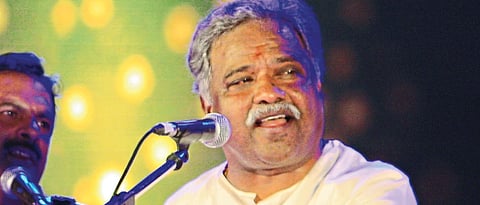

How to be a student and how to be a guru is best epitomised by the relation between Pt M Venkatesh Kumar and Gaana Yogi Panchakshara Pt Puttaraj Gawai. A son of a puppeteer and folk singer, Venkatesh Kumar went on to study Hindustani classical music in Veereshwara Punyaashrama in Gadag, in north Karnataka. He alongwith other students, adhered to the strict discipline set by his guru.
“My father had learnt Carnatic music but he wanted me to study Hindustani classical music. So I enrolled in Veereshwara Punyaashrama. The training was rigorous. We woke up at 4 am and said our prayers. Then, we did sangeet abhyasa (practise) till 7 am. If we didn’t wake up on time, we had to forgo food for the entire day,” reminisces the veteran artist, who would be performing in the city this evening at Gaanasaraswati Mahotsav.
His training at the ashram was not only confined to music lessons. But he learnt what it means to surrender to his guru by doing guru and ashram sewa (service). “After the morning practice, the students contributed to ashram seva till noon. From noon to 2 pm, we practised again and in the evenings too, we did abhyasa. Between 6 and 8 pm, we said our samuhik prarthana (group prayers). By 8 pm, we finished our dinner and we were in bed by 9 pm. This was my routine for the 12 years that I studied music in the ashram,” says Pt Venkatesh Kumar.
The Hindustani classical vocalist from Kirana and Gwalior gharana elaborates on Guru sewa and says, “Guru sewa means conducting yourself the way your guru does, adhering to the discipline and presenting his teachings through performances. It’s very rare to have ‘Guru Karuna’ and once acquired, it’s a blessing in itself.”
He adds, “Following your guru’s teachings is in your hands and you must do it diligently. A teacher can teach for two hours but a student must practise for 10 hours. You must regularly do riyaaz you have been taught and must be engrossed in it for 24 hours to reach a certain stage.”
The artist, who was in touch with Pt Gawai till he passed away at the age of 97, recounts one incident when his guru encouraged him to take criticism in the right spirit.
“The Belgaum Art Circle had organised a three day music fest with three performers each day. I performed on the last day. An article was published on the festival and the performances of the artists. It said, ‘The three day music fest was well organised and all the performers performed well.
But on the last day, Venkatesh Kumar didn’t know which raag to perform’. One of my acquaintances showed me the article and suggested that I go to Pt Gawai and seek his views. After he read the article, my guru said what the article said was correct. That was an eye opener and after this, I would meet guruji to take his advice on what to perform before every concert,” he says.
However, the form of classical music concerts has changed over the years and with that has changed the presentation of the artists. “Earlier, classical programmes were conducted all night long and therefore we could present the time-specific raagas. With the advent of TV and other gadgets, the audiences could listen or watch the performances at their own convenience. Thus, the frequency of the night-long programmes was reduced considerably. Having said that, I think the calibre of an artist can also be judged by two or three hours of performance,” observes Venkatesh Kumar.
A discerning audience attending the concerts can also favourably lift the performances of the artists to great heights and there are certain pockets in the country where classical arts get their due. Hubli and Dharwad regions have produced many a great artists like Vidushi Gangubai Hangal, Pt Mallikarjun Mansur, Pt Basavraj Rajguru and in Pune, they found a very good audience, with a keen ear for music. Acknowledging the contribution of these centres, Pt Venkatesh Kumar says, “In Karnataka, the main centre for Hindustani classical music is Dharwad and in Maharashtra, Pune and Mumbai are the main homes for art connoisseurs. Kolkata and Chennai also have retained the cultural pride over the years. It’s an honour for any artist to perform before such a learned audience.”
ST Reader Service
Pt M Venkatesh Kumar’s performance will end the second day (February 8) of the Gaanasaraswati Mahotsav 2020. The festival is being organised at Mahalakshmi Lawns, near Rajaram Bridge, 5 pm onwards. Donation passes available at www.bookmyshow.com and www.zoonga.com
